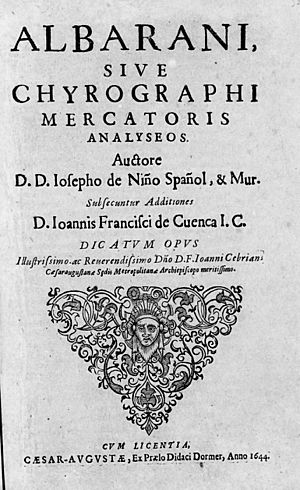Juan Francisco de Montemayor Cordoba and Cuenca facts for kids
Juan Francisco de Montemayor Cordoba and Cuenca (born 1618, died 1685) was an important Spanish lawyer and judge. He was a leader in Santo Domingo (now part of the Dominican Republic) from 1660 to 1662. Later, he worked as a judge in Mexico from 1667 to 1682. He is also known for taking back Tortuga Island from pirates. Besides his work in government, he wrote many books about law, politics, and how society works.
Contents
Early Life and Education
Juan was born in 1618 in Laluenga, a town in Spain. He was baptized on September 7, 1618. His parents, Nadal de Montemayor de Cuenca and María de Lissa, were farmers. They owned houses and land in Laluenga. Juan also had a brother named Ambrosio.
Juan came from a noble family. He was the lord of the village of Alfocea. He went to school in Laluenga. Later, he studied jurisprudence (the study of law) at the University of Huesca. Around age 15, he began his legal career.
Career in Government
In 1642, Juan became a judge for the Crown of Aragon. He also became an auditor in Catalonia. In 1643, he was named General Commissioner and Auditor General of the Army.
Governor of Santo Domingo
In 1645, Juan traveled to Santo Domingo. There, he served as a judge for the royal court. He later became the dean, president, and governor of the island. Finally, he was named captain general of Santo Domingo.
As captain general, Juan worked to bring peace to the island. He helped manage relations with the Native Americans. He also fought against French, English, and Dutch colonists. These groups, along with buccaneers (pirates), often attacked Spanish areas.
Juan successfully took back Tortuga Island from French buccaneers. He then defended it from English attacks. He also strengthened the defenses of Santo Domingo Island. He reorganized the local militias (citizen soldiers) to protect the area.
Judge in Mexico
In 1657, the Spanish crown recognized Juan's success. They made him a judge for the Royal Chancellery of Mexico. In Mexico, he continued his policy of working with local people. He also helped improve the public finances, which were in bad shape. From 1669 to 1673, Juan was also the police judge of Mexico City.
Later Life
Juan retired in 1682. He returned to Huesca, Spain. He passed away on August 21, 1685. Some believe he might have died in Madrid instead.
He was first buried in a church in Huesca. Later, his body was moved to the church in Alfocea village. This was his wish. In this church, you can still see his portrait and a special inscription. It mentions that he helped pay for the church's construction.
Writings
Juan was also a writer. He wrote many books, mostly about law. His works can be grouped into four types:
- Books about general civil law or Aragonese law.
- Books specifically about Aragon law.
- Books about legal issues in the Americas.
- Books about church-related topics.
Some of his most important works include:
- Of sui personalique defensione (1645)
- Historical discourse, legal juridical of the law and repartimiento of prey and despojos apprehended in just war (published in Mexico in 1658). This was the first book about the rights of people published in America.
- Excubationes semicentum ex decisionibus regia chancellariae Sancti Dominici insulae, vulgo dictates Spanish, totius novi orbis primatis compaginatas edit (1667)
- Propugnatio pro regia jurisdictione, et auctoritate (1667)
- Summaria investigation of the origin and priveleges of the Rich Men or Nobles, Knights, Infanzones or Sons Dalgo and Lords of Vasallos de Aragón and of the absolute power that they have in them (1664). This was the first book about heraldry (family symbols and history) written in America.
- Summary compilation of some commandments and ordinances of the government of this New Spain (1677)
- Summary compilation of some agreed cars (1677)
Family
Juan Francisco de Montemayor Cordoba and Cuenca did not have any children. His brother Ambrosio's children were his only heirs. These were Ventura Montemayor Córdoba of Cuenca, Juan Francisco de Montemayor, and Ana de Montemayor and Córdoba.
See also
 In Spanish: Juan Francisco de Montemayor Córdoba y Cuenca para niños
In Spanish: Juan Francisco de Montemayor Córdoba y Cuenca para niños



